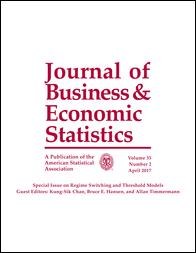
Koopman, S., Mallee, M. and \van der Wel\, M. (2010). Analyzing the term structure of interest rates using the dynamic Nelson-Siegel model with time-varying parameters Journal of Business and Economic Statistics, 28:329--343.
-
Affiliated authors
-
Publication year2010
-
JournalJournal of Business and Economic Statistics
In this article we introduce time-varying parameters in the dynamic Nelson-Siegel yield curve model for the simultaneous analysis and forecasting of interest rates of different maturities. The Nelson-Siegel model has been recently reformulated as a dynamic factor model with vector autoregressive factors. We extend this framework in two directions. First, the factor loadings in the Nelson-Siegel yield model depend on a single loading parameter that we treat as the fourth latent factor. Second, we specify the overall volatility as a generalized autoregressive conditional heteroscedasticity (GARCH) process. We present empirical evidence of considerable increases in within-sample goodness of fit for these advances in the dynamic Nelson-Siegel model. {\textcopyright} 2010 American Statistical Association.